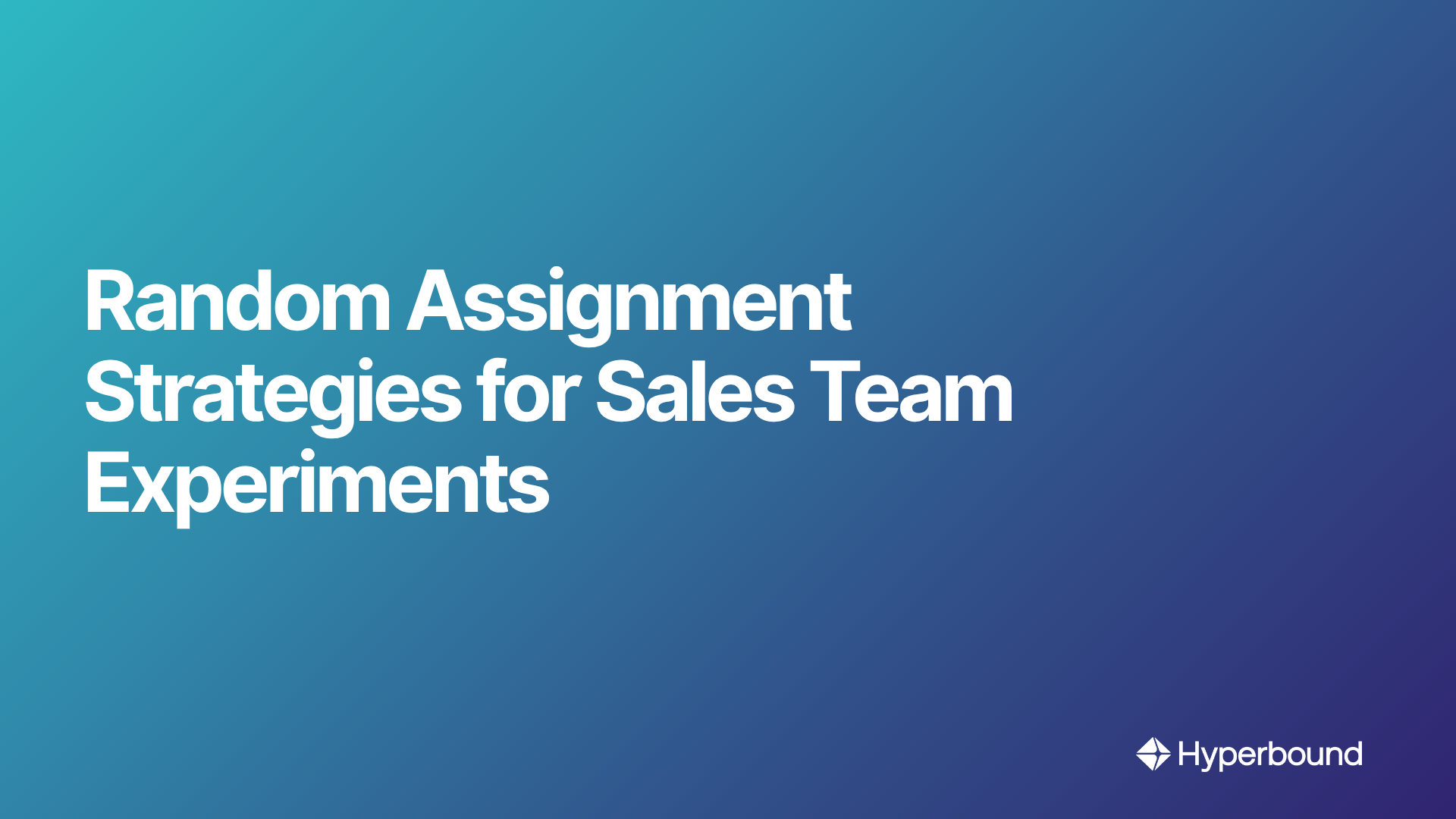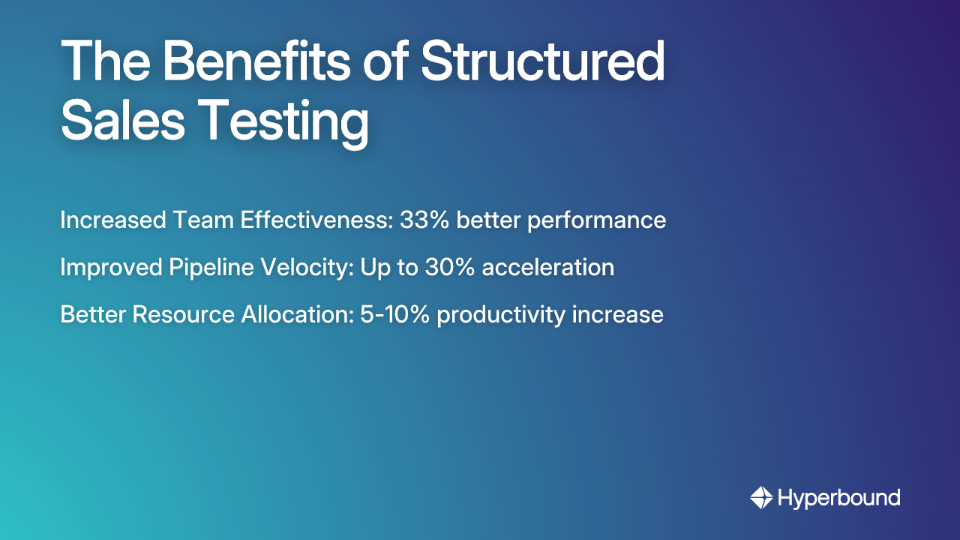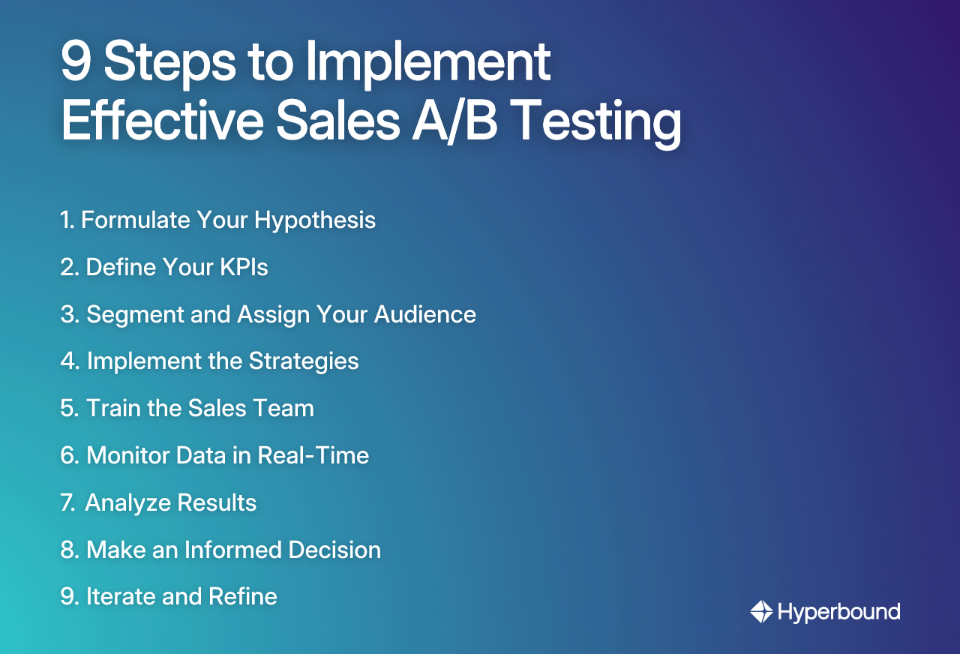
Are you launching a new service with no existing conversion rate benchmark? Do you worry that variables you cannot control, including staff capacity, data quality, and other factors, will poison your results? Does the thought of manually assigning hundreds of prospective customers to different strategies feel overwhelming?
You're not alone. Many sales leaders are concerned that testing conversion rates across many segments simultaneously may lead to inaccurate conclusions. Yet without proper testing, you're essentially playing a high-stakes guessing game with your sales strategy.
While A/B testing is the solution to this uncertainty, improper setup can lead to useless—or worse, misleading—data. The foundation of any reliable sales experiment is random assignment, and implementing it correctly can be the difference between actionable insights and costly misdirection.
This article provides a practical, step-by-step guide to implementing robust randomization techniques in your sales A/B tests, helping you move from guesswork to data-driven decisions.
Why Randomization is Your Secret Weapon for Sales Growth
Random assignment in a sales context means giving each prospect an equal, unbiased chance of experiencing either your control (current) strategy or your test (new) strategy. Its primary benefit is creating equivalent groups to ensure that any observed differences in performance are due to the strategy itself, not the characteristics of the prospects.
According to the Office of Research Integrity, random assignment's main goal is to ensure the only systematic difference between your control groups and test groups is the strategy you're testing. This gives you confidence that changes in outcomes are due to the treatment, not other factors.
The cost of getting randomization wrong is significant. Research shows that inadequate randomization can lead to an overestimation of treatment effects by as much as 40%, potentially causing you to adopt strategies that aren't actually better.

On the flip side, the measurable benefits of a structured testing culture include:
- Increased Team Effectiveness: Sales teams with structured playbooks (developed through testing) perform 33% better
- Improved Pipeline Velocity: Testing can accelerate the pipeline by up to 30%
- Better Resource Allocation: Successful sales planning increases productivity by 5-10%
Choosing the Right Randomization Method for Your Sales Test
Not all randomization is created equal. Here are four key methods, translated from academic concepts into practical sales applications:
Method 1: Simple Randomization (The Coin Flip)
Description: Every prospect has an equal chance of being assigned to any group. Like flipping a coin for each lead.
How-to: In a spreadsheet, create a new column and use the formula =RAND(). Sort your list by this column and assign the top 50% to Group A and the bottom 50% to Group B.
Best for: Large prospect lists where the law of large numbers will likely create balanced groups.
Caveat: Can result in unbalanced groups in small sample sizes (e.g., testing with only 20 prospects).
Method 2: Block Randomization (Forced Balance)
Description: Randomize prospects in small blocks to ensure the number of prospects in each group stays balanced throughout the assignment process.
How-to: Decide on a block size (e.g., 6). For each block, you'd pre-determine that 3 go to Group A and 3 go to Group B, then randomize the order within that block (e.g., A, B, B, A, B, A).
Best for: Ensuring sales reps have an equal number of leads for each strategy, which is critical when you have concerns about staff capacity.
Method 3: Stratified Randomization (Testing Like with Like)
Description: First divide prospects into subgroups (strata) based on a key characteristic, then randomize within each subgroup.
How-to:
- Define Strata: Segment your prospect list by a crucial KPI like LTV (Lifetime Value), company size, industry, or lead source.
- Randomize Within Strata: Apply simple or block randomization to each stratum individually. This ensures both high-LTV and low-LTV prospects are equally represented in Group A and Group B.
Best for: When you have a key variable that you know strongly influences the conversion rate and you want to ensure the test is fair across those segments.
Method 4: Covariate Adaptive Randomization (The Balancing Act)
Description: This method continually adjusts the probability of assignment based on the current balance of covariates (important characteristics) in each group.
How-to: As you assign prospects one by one, you check the current balance of key characteristics (like LTV, industry, etc.) between groups and adjust the randomization to favor assignment that would improve balance.
Best for: Complex sales environments with multiple important variables and smaller sample sizes.
Practical Tools: You don't have to do this entirely by hand. Tools can help generate randomization schedules:
The Playbook: A Step-by-Step Workflow for Implementing a Sales A/B Test

Step 1: Formulate Your Hypothesis
A good hypothesis is a clear, testable statement. For example: "For our SMB segment, a sales strategy focused on prioritizing follow-up calls will result in a 15% higher meeting-booked rate (conversion rate) compared to a strategy focused on maximizing new first-time calls."
Step 2: Define Your KPIs
Don't just track the final conversion:
- Primary Metric: Meeting-booked rate, close rate percentage
- Secondary Metrics: Time to close, average deal size, customer satisfaction scores post-purchase
Step 3: Segment and Assign Your Audience
Example Workflow in a Spreadsheet:
- Export prospect list to CSV with columns:
Prospect ID,Name,LTV_Category - Add a new column:
Random_Number. Use the formula=RAND() - Sort the entire sheet first by
LTV_Category, then byRandom_Number - Add a new column:
Assigned_Group - Within each LTV category, assign the top 50% to "Strategy A (Control)" and the bottom 50% to "Strategy B (Test)"
- Import this back into your CRM with a custom field for the assigned group
Step 4: Implement the Strategies
Clearly document Strategy A (Control) and Strategy B (Test) in a sales playbook. For example:
Strategy A (Control): Focus on maximizing the number of new prospects contacted. Reps should make at least one attempt to reach each prospect before making any follow-up calls.
Strategy B (Test): Prioritize follow-up calls to prospects who have already been contacted once. Make up to 3 attempts to reach each prospect before moving to new names.
Step 5: Train the Sales Team
This step is critical for execution integrity. Ensure every rep on the test understands both strategies and when to apply them:
- Create clear guidelines for when to use each strategy based on the assigned group
- Conduct role-playing exercises to practice both approaches. Platforms like Hyperbound's AI Sales Roleplays provide a scalable way for reps to master new talk tracks in a safe environment.
- Set up a system for reps to easily identify which strategy to use for each prospect

Step 6: Monitor Data in Real-Time
Use your CRM as the single source of truth. As noted in research on sales challenges, a CRM is essential for streamlining processes and tracking metrics:
- Set up dashboards to track key metrics for each group separately
- Schedule regular check-ins to ensure the experiment is running as designed
- Be prepared to address any implementation issues quickly
Step 7: Analyze Results
Once the test period is over, compare the performance of your KPIs between the two groups. Significance testing is crucial to determine if the difference is real or just due to random chance.
Tools like A/B Test Calculator can help you determine if your results have reached statistical significance.
Step 8: Make an Informed Decision
Adopt the winning strategy, or if results are inconclusive, analyze why:
- Was the sample size too small?
- Was the test duration too short?
- Were there external factors that may have influenced the results?
Step 9: Iterate and Refine
Continuous testing is key. Use findings to inform your next hypothesis. The most successful sales organizations maintain a culture of ongoing experimentation and refinement.
Navigating the Real-World Mess: Overcoming Common Challenges
Challenge: "We're launching a new service and have no baseline conversion data."
Solution: This is the perfect time to test! Your control group creates your baseline. Run your current best-guess strategy as the control (Group A) against a new idea (Group B). The performance of Group A becomes your benchmark for all future tests.
Challenge: "There are too many variables I can't control, like staff availability and data quality."
Solution: This is exactly what random assignment is designed to solve. By randomizing, you ensure that both good and bad quality data, and reps with different availability, are likely to be distributed evenly between groups, neutralizing their impact on the result. Use Block Randomization to manage staff workload fairly.
Challenge: "I'm concerned about testing across many segments at once and getting inaccurate conclusions."
Solution: Your concern is valid. The best practice is to test one big change at a time. If you must test across segments, use Stratified Randomization. This allows you to analyze the results for "High LTV" prospects separately from "Low LTV" prospects, giving you clearer, more accurate insights for each group.
Challenge: "My sales team fears that testing will disrupt their workflow and hurt their numbers."
Solution: Cultivate a "test-and-learn" culture. As noted by Harte Hanks, this involves fostering curiosity.
- Start small: Run your first test on a lower-priority segment to minimize risk
- Demonstrate value: Share wins and data-backed results to show how testing helps everyone perform better
- Involve the team: Ask reps for their ideas on what to test. This creates ownership
Challenge: "We're struggling with how to calculate LTV for prospective customers."
Solution: For new services without established LTV data, consider using proxy metrics from similar services or segments. Alternatively, segment prospects based on other characteristics like company size, industry, or potential impactable healthcare spend that correlate with future value. Remember that the goal of randomization is to create comparable groups, so consistency in your approach is more important than perfect accuracy at this stage.
Stop Guessing, Start Testing
Random assignment is the crucial step that transforms a messy A/B testing idea into a reliable engine for sales growth. In a competitive market, relying on gut feelings is a recipe for falling behind. The most effective sales teams are those that embrace continuous, data-driven experimentation.
What's one assumption about your sales process you can finally prove or disprove using proper randomization techniques? Identify a simple hypothesis you can test next week using the step-by-step playbook provided. Even a small, well-designed experiment can yield insights that dramatically improve your outbound calling strategies and conversion rates.
By implementing rigorous random assignment in your sales experiments, you'll gain the confidence to make bold strategy decisions backed by reliable data, not just intuition. Your prospects will be none the wiser about being part of an experiment, but your bottom line will certainly notice the difference.
Frequently Asked Questions
What is random assignment in sales A/B testing?
Random assignment is the process of giving every prospect an equal and unbiased chance of being placed into either a control group (your current strategy) or a test group (your new strategy). This method is crucial for creating equivalent groups at the start of an experiment. By neutralizing the effects of pre-existing differences among prospects, you can confidently attribute any changes in conversion rates or other KPIs directly to the strategy being tested.
Why is randomization so important for accurate sales experiments?
Randomization is important because it minimizes selection bias and ensures that the only systematic difference between your test groups is the strategy you are evaluating. Without proper randomization, you risk creating unbalanced groups where one group might accidentally contain more high-value prospects. This can lead to misleading results, causing you to adopt an ineffective strategy or discard a winning one.
How do I choose the right randomization method for my sales test?
The best randomization method depends on your sample size and the key variables you need to control for. For very large prospect lists where balance is likely to occur naturally, Simple Randomization is sufficient. Use Block Randomization when you need to ensure an even split of leads between sales reps. If a specific characteristic like company size strongly influences outcomes, use Stratified Randomization to ensure that variable is balanced across your test groups.
What is the minimum sample size for a reliable sales A/B test?
There is no single magic number for sample size; it depends on your baseline conversion rate and the expected improvement you want to detect. As a general rule, the smaller the expected difference between strategies, the larger the sample size you'll need to achieve statistically significant results. You can use online sample size calculators to get a more precise estimate before you begin.
How long should I run a sales A/B test?
A sales A/B test should run long enough to collect a sufficient sample size and to account for the full length of your typical sales cycle. Running a test for only a few days can capture unusual fluctuations. It's best practice to run the test for at least one full business cycle (e.g., several weeks) to ensure your results are stable and representative of typical customer behavior.
What if my sales team is resistant to running an experiment?
Overcome resistance by involving the sales team in the process, starting with a small, low-risk test, and clearly demonstrating the value of the insights gained. Frame the experiment as a "test-and-learn" opportunity, not a judgment of their current methods. Ask for their input on what to test, and when you share back data-driven wins that help them close more deals, you'll build buy-in for a culture of continuous improvement.
Can I test more than two sales strategies at the same time?
Yes, you can test more than two strategies at once in what is known as an A/B/n test. However, be aware that each additional strategy you test requires a significantly larger sample size to achieve statistically significant results for each variation. If you're just starting out, it's often more effective to stick to a simple A/B test (one control vs. one variant) to get clear, actionable results more quickly.

Book a demo with Hyperbound
.png)













